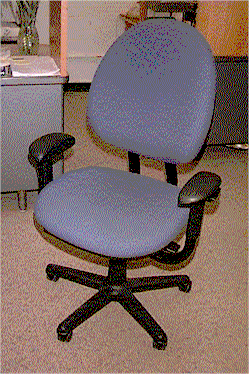
Cornell University Ergonomics Web

Cornell University Ergonomics Web
DEA 651: Evaluation of Proposed Ergonomic Workstations in Olin Library
Workstation #4: Evaluation
This page includes evaluation and images of Workstation #4.
Abstract | Workstation #1 | Workstation #2 | Workstation #3
Workstation #4 | Workstation #5 (C) | Existing Workstation
Posture Analysis | Reach Envelope
The primary duty of the users of Station 4 is data entry. This requires periods of sitting, typing, and mousing as well as reaching and lifting. This workstation comfortably allows both sitting and typing; however mousing and reaching were more difficult due to the intricacies of the workstation design.
The overall impression of this Steelcase workstation was moderate. There were many positive qualities; however, there were also areas that should be reconsidered. The user and the evaluator appreciated the aesthetic appearance of this corner angled workstation. It provides for more work surface area as the computer terminal had an area all its own. (see image). A question to consider is does the user require this additional quantity and depth of workspace for the type of work that is being performed.
The chair at this station allowed the user to sit comfortably with minimal obstructions or pressure points. The seat height, backrest, and arm rest heights on the Steelcase chair, model #4535331DW are adjustable. The space between the two armrests is quite wide and does not accommodate a user with a narrow body frame. Therefore, no support is provided to the arms of a narrow framed person during keyboard use (see image).
The keyboard tray is gravity assisted providing many positions to accommodate a wide variety of users. The initial response was positive due to the span of adjustablity. After working at the station, it was found the keyboard tray is so easy to adjust that it was difficult to maintain a position once selected. This was especially evident when the user attempted to stow the tray to perform a reaching task. When this occurred the keyboard slipped out of the selected position requiring the user to spend a large amount of time re-adjusting to the originial selection. Using a tray which offers a similar range of adjustablity, but maintains the selected position would be beneficial. By allowing the user to slide the tray in and out from the station , they could then move the chair to a desired item rather than reach for it. This would help to reduce stress during reaching activities (see reach envelope).
It should also be noted that the mousepad, which is an extension of the keyboard tray, causes the user to abduct the arm when mousing (see image). One possibility to decrease stress to the arm and shoulder is to install a tray where the height and location of the mousepad are independently adjustable from the keyboard.
 |
The RULA scores for
this station are as follows. For general typing the score
was a 3, with the score raised by the upper arm being
abducted. Reaching for paper caused the RULA score to increase to a 4 due to the upperarm being raised and abducted and the arms crossing the midline of the body as well as an increase in load. Overall, this station has many positive qualities. To optimize comfort and minimize potential cumulative trauma injuries, however, it is recommended that a more stable keyboard tray with an independent mouse pad be utilized as well as a chair that accommodates narrow body frames. |
Abstract | Workstation #1 | Workstation #2 | Workstation #3
Workstation #4 | Workstation #5 (C) | Existing Workstation
Posture Analysis | Reach Envelope
This page created by DEA 651: Ergonomics,
Anthropometrics, and Biomechanics,
Send questions or comments to rlp6@cornell.edu.
Last updated January 25, 2009